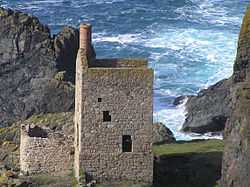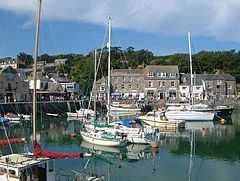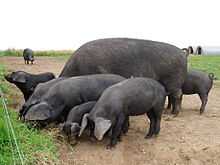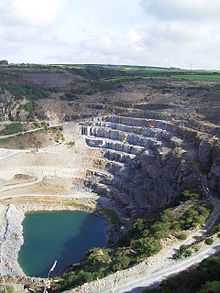Economy of Cornwall
The economy of Cornwall (Cornish: Ekonomieth Kernow), in South West England, is largely dependent upon agriculture followed by tourism. Cornwall is one of the poorest areas in the United Kingdom with a GDP of 62% of the national average,[1] and is one of four UK areas that qualifies for poverty-related grants from the EU (European Social Fund). Farming and food processing put £1 billion a year into the Cornish economy in 2007. The Cornish economy also depends heavily on its successful tourist industry which contributes 24% of Cornwall's GDP[2] and supports about 1 in 5 jobs (19% in Kerrier, Restormel and Scilly, 24% in Penwith, 23% in North Cornwall, 22% in Carrick and 14% in Caradon).[3]
Statistics
This is a chart of trend of regional gross value added of Cornwall and Isles of Scilly at current basic prices published (pp. 240–253) by Office for National Statistics with figures in millions of British Pounds Sterling.
| Year | Regional Gross Value Added[4] | Agriculture[5] | Industry[6] | Services[7] |
|---|---|---|---|---|
| 1995 | 3,230 | 235 | 813 | 2,182 |
| 2000 | 4,245 | 198 | 1,021 | 3,027 |
| 2003 | 5,401 | 221 | 1,195 | 3,985 |
Objective One funding in Cornwall
Cornwall qualified for Objective One European funding in 1999. Prior to this the Government had, for statistical purposes, incorporated it with Devon, under the Devonwall concept. In 1998 Cornwall was recognised by the UK Government as having "distinct cultural and historical factors reflecting a Celtic background",[8] thus allowing it to be separated in a regional and economic sense from Devon.
Due to Cornwall producing less than 75% of the average European GDP, £350 million of Objective One funding was received between 2000 and 2006. The Combined Universities Campus at Tremough was one result of this funding. Objective One funding has been used in supporting and developing a largely indigenous food and farming industry which is now worth nearly two billion pounds a year. Other sectors have also benefited, including the 'creative industries', which have benefited from publicity and investment. Tourism also gained from the funding, and broadband provision was made a priority. There have been some complaints of fund mismanagement, for example, cases such as the £2 million funding towards the failed South West Film Studios at St Agnes.[9]
In 2005, Cornwall was estimated to have a GDP of 70% of the European average and Cornwall qualified once again for Objective One.[10] This 'tranche' was known as Convergence funding, and was due to last between the beginning of 2008 and 2013, and be worth £445 million. Priorities for the 2008–13 tranche have an emphasis on information and communication technologies, competitiveness, enterprise and a providing a skilled workforce.
One of the first projects, a £3.5 million factory was built by the South West Regional Development Agency (SWRDA) at St Columb Major with £1.7 million of Objective One funding in January 2002. It was occupied by the American-owned book, video and CD distribution company Borders Books, creating 90 jobs, and became the company's national distribution centre. In March 2008 it was announced that the depot was to close.[11]

The Gaia Energy Centre at Delabole, opened in 2001 as a tourist attraction (on the site of Britain's first commercial windfarm). It cost £5m and was expected to attract 150,000 visitors a year. It closed after three years, having only welcomed one tenth of the expected visitor numbers. The majority of the funding for the centre came from Europe, with £300,000 grants from Objective One and SWDRA, the South West Regional Development Agency.[12]
Tourism

Cornwall's unique culture, spectacular landscape and mild climate make it a popular tourist destination, despite being somewhat distant from the United Kingdom's main tourist centres. Surrounded by the Celtic Sea and English Channel, Cornwall has miles of beaches and cliffs. Other tourist attractions include moorland, country gardens and wooded valleys, and tourism is a significant sector of the economy.
In 2003, five million tourists were visiting Cornwall each year, mostly drawn from within the UK,[13] making up around a quarter of the economy. In particular, Newquay is a popular destination for surfers. In 2004 the Eden Project near St Austell was considered to be a major financial success, drawing one in eight of Cornwall's visitors,[14] though in 2007 it lost its bid to receive an extra £50m lottery grant (for a major expansion) in a public vote.[15]
Visitors to Cornwall are served by airports at Newquay and Plymouth, whilst private jets, charters and helicopters are also served by Perranporth airfield; nightsleeper and daily rail services run between Cornwall, London and other regions of the UK.
The Cornwall and West Devon Mining Landscape, which includes select mining landscapes across Cornwall and West Devon, has been a World Heritage Site since July 2006.
Industry
Agriculture and food





The expansion of the railway system in the 19th century led to the export of vegetable products, including flowers, becoming a profitable business for Cornwall. Revd. Canon Arthur Townsend Boscawen (1862-1939) rector of Ludgvan 1893 to 1939, was instrumental in founding the Cornish anemone industry. He also introduced broccoli as a commercial crop from imported German seed.[16] The wet climate and relatively poor soil of Cornwall make it unsuitable for growing many arable crops,[17] but the conditions are ideal for growing the rich grass required for dairying, leading to the production of Cornwall's other famous export, clotted cream. Though it has declined significantly agriculture is still of economic importance.
Ginsters in Callington is a mass manufacturer of Cornish pasties. Dairy Crest has a large cheese factory at Davidstow and A. E. Rodda of Scorrier is a supplier of clotted cream. Furniss of Truro manufactures biscuits. There are many types of beer brewed in Cornwall, including Sharp's Brewery, Skinner's Brewery and St Austell Brewery. There is some small scale production of wine, mead and cider.
Flower farming was a profitable industry on the Isles of Scilly for most of the 20th century. In a 1987 study of the Scillonian economy, S. Neate found that many farms on the islands were struggling to remain profitable due to increasing costs and strong competition from overseas producers, with resulting diversification into tourism. Recent statistics suggest that agriculture on the islands now represents less than 2 percent of all employment.[18][19][20] Flower farming was also carried on in parts of west Cornwall but has declined due to increasing costs and strong competition from overseas producers.
Pre-19th century agriculture
William Borlase gave an account of Cornish agriculture in his Natural History of Cornwall, 1758. He notes that two centuries earlier the art of husbandry was little practised by the Cornish, who let out their land to tenants from Devon and Somerset who kept cattle on it while they concentrated on tin mining. As the population increased the disadvantage of this became clear as the demand for agricultural products was rising while that for tin was subject to falls as well as rises. By the end of Queen Elizabeth's reign the farmers of Cornwall were in a position to supply their own population and to export corn to Spain and elsewhere. Since that time there had been continual progress and well fenced and profitable arable land was to be found near the larger rivers and the main ports. In some places lime was used for manure but marl though it is found in the county was little used except in bringing uncultivated land into use. Seaweed, to which sand is sometimes added, was also used and near the fishing ports decayed pilchards and salt used in curing them were both bought at a low price for use as manure. The crops grown are wheat, barley, oats and rye, as well as Avena nuda (called in Cornwall pilez). Pilez is used as a substitute for oatmeal and for fattening calves. Rye was then grown less than previously and the growing of barley had increased since it was needed both for bread and for beer. The Cornish measure of grain is irregular: one bushel consists of three winchesters, or 24 gallons. Trefoil and sainfoin are sown to improve pasture land. Turnips were then a relatively new crop; two sorts of potato were grown, the flat or kidney potato (planted in winter, harvested in June and would last until Christmas) and the round potato (planted in spring, harvested at Christmas and would last until the following autumn). At that time only the most productive parts of east Cornwall produced enough grain to support their population; in the west there was a greater population and the farming was less productive. Borlase emphasises the importance of improving agriculture since mining alone would not support the people. "Husbandry ... can employ and subsist a people without mining, but mining can do neither without husbandry."[21]
Fishing
Fishing in Cornwall has traditionally been one of the main elements of the economy. Pilchard fishing and processing was a thriving industry in Cornwall from around 1750 to around 1880, after which it went into an almost terminal decline. During the 20th century the varieties of fish taken became much more diverse and crustaceans such as crab and lobster are now significant. Much of the catch is exported to France due to the higher prices obtainable there. Though fishing has been greatly affected by EU fishing policies and significantly damaged by overfishing it is still important. The Southwest Handline Fisherman's Association has started to revive the industry.[22]
Mining and quarrying

Mining of tin, copper and some rarer metals was one of the county's principal industries until well into the 20th century, but it no longer exists—the last working tin mine in Europe, South Crofty, near Camborne, finally closed in 1998, but in November 2007 it was announced that the mine may restart production in 2009,[23] though as of mid-2012 this has not yet occurred. Several defunct mines applied for status as UNESCO World Heritage Sites.[24] However, the Camborne School of Mines is still a world centre of excellence in its field.[25]
The extraction of china clay continues to be of considerable importance: the larger works are in the St Austell district. Extraction of slate and roadstone by quarrying still continues on a reduced scale: it was formerly an important industry and it has been carried on in Cornwall ever since the Middle Ages.[26] Several quarries have been productive enough to need their own mineral railways.
World Heritage Status was granted to the Cornwall and West Devon Mining area in 2006. This allowed Cornwall County Council the opportunity to expand its Mineral Tramways Project of walking trails along with re-instatement of engine houses and other places of mining interest. Completion of this network was expected some time in 2008.[27]
Creative industries
Cornwall has been known as a popular residence for artists and writers since the end of the 19th century, see the St Ives School, for instance. In recent years Cornwall's creative industries have undergone significant growth, thanks in part to the Objective One funding. There is now a significant creative industry in Cornwall, encompassing areas like graphic design, product design, web design, packaging design, environmental design, architecture, photography, arts and crafts. There are also many small publishers producing works mainly of local interest.
Deprivation and poverty
The official measures of deprivation and poverty at district and 'sub-ward' level show that there is great variation in poverty and prosperity in Cornwall with some areas among the poorest in England and others are among the top half in prosperity. For example, the ranking of 32,482 sub-wards in England in the index of multiple deprivation ranges from 749th (part of Camborne) to 30,387th (Latchbrook South), where the lower number represents the greater deprivation. See also: Deprivation in Cornwall
In the October 2001 Business Age magazine, Kevin Cahill, an author and investigative journalist for the Sunday Times, wrote about the economy of Cornwall. In The Killing of Cornwall, he noted that the London Treasury extracted £1.95 billion in taxes out of Cornwall's GDP of £3.6 billion, but returned less than £1.65 billion, causing a net loss to Cornwall of 300 million pounds, where the total earnings figure is 24% below the national average. Cahill said that this "completely explains the increasing pace of impoverishment in Cornwall" and noted that Cornwall would not recover until the gap between the tax 'take' and the Government's 'give' is at least neutralised and better still, reversed.
South West Regional Assembly and South West Regional Development Agency
On Tuesday 17 July 2007, Local Government Minister John Healey MP announced Government plans to abolish regional assemblies. Functions of regional assemblies were planned to pass to Regional Development Agencies in 2010.[28][29] The South West Regional Assembly was due to be replaced by the South West Regional Development Agency in 2010. There was opposition to the formation of the South West Regional Assembly with critics saying it is an unelected, unrepresentative and unaccountable "quango", and the area covered is an artificially imposed region and not natural.[30] This opinion is based upon geography, arguing that having the Isles of Scilly and Cornwall in the same region as Gloucestershire would be comparable as linking London with Yorkshire.[31] The feeling was especially strong in Cornwall where in July 2000 Mebyon Kernow issued the "Declaration for a Cornish Assembly".[32] In Oct 2007 Lib Dem MP Andrew George stated in a press release, "Just because the Government has approached the whole Regional Devolution agenda in entirely the wrong way, does not mean to say that the project itself should be ditched. If Scotland and London are benefiting from devolution then Cornwall should learn from this and increase the intensity of its own campaign for devolution to a Cornish Assembly."[33]
See also
References
- ↑ Peter Kingston, 2005. "Closed for Business". The Guardian, Tuesday 10 May 2005.
- ↑
- ↑ Cornwall Council tourism stats
- ↑ Components may not sum to totals due to rounding
- ↑ includes hunting and forestry
- ↑ includes energy and construction
- ↑ includes financial intermediation services indirectly measured
- ↑ Hansard 1998 – Cornwall has distinct cultural and historical factors reflecting a Celtic background
- ↑ BBC news Jan 2005 – Cornish Euro regeneration cash 'wasted'
- ↑ BBC news 2004 – EU cash to keep flowing
- ↑ BBC news – March 2008 – Ninety Cornish jobs to go as depot shuts
- ↑ BBC news – September 2004 – Energy tourist attraction shuts
- ↑ Cornwall Tourist Board, 2003. Tourism in Cornwall.
- ↑ Scottish Executive, 2004. A literature review of the evidence base for culture, the arts and sport policy
- ↑ BBC News – Dec 2007 – Eden Project fails to win extra £50m lottery grant
- ↑ Dudgeon, Piers (1991) The English Vicarage Garden
- ↑ Young, Andrew (October 2007 (PDF version 2011)). "Cornwall and Isles of Scilly Mapping Project" (PDF). Cornwall County Council. Retrieved 24 September 2012. Check date values in:
|date=(help) - ↑ Gibson, F., My Scillionian Home... its past, its present, its future, St Ives, 1980
- ↑ Isles of Scilly Integrated Area Plan 2001–2004, Isles of Scilly Partnership 2001
- ↑ Neate, S, The role of tourism in sustaining farm structures and communities on the Isles of Scilly in M. Bouquet & M. Winter (eds.) Who From Their Labours Rest? Conflict and practice in rural tourism. Aldershot, 1987
- ↑ Borlase, William (1758) Natural History of Cornwall ... Oxford: printed for the author; by W. Jackson: sold by W. Sandby, at the Ship in Fleet-Street London; and the booksellers of Oxford; reissued by E & W Books, London, 1970; pp. 85–90
- ↑ Line-caught wild bass from Cornwall – South West Handline Fishermen's Association
- ↑ BBC News Nov 2007 – Tin mine aims to re-open in 2009
- ↑ UNESCO Page on the Cornwall & West Devon application
- ↑ The University of Exeter :: Cornwall Campus :: Camborne School of Mines
- ↑ Hatcher, John (1970) Rural Economy and Society in the Duchy of Cornwall 1300–1500. Cambridge University Press ISBN 0-521-08550-0
- ↑
- ↑ Dan Rogerson MP – New powers for Cornwall 'In sight'
- ↑ BBC news July 2007 – Regional assemblies will be axed
- ↑ Mebyon Kernow opposes SWRA
- ↑ Senedh Kernow
- ↑ Government get Cornish Assembly call
- ↑ Andrew George MP – Press Release 29 October 2007
Further reading
- Todd, A. C. & Laws, Peter (1972) The Industrial Archaeology of Cornwall. Newton Abbot: David & Charles
- Worgan, George B. (1815) General View of the Agriculture of the County of Cornwall; drawn up for the consideration of the Board of Agriculture (1793) and Internal Improvement by G. B. Worgan. London: Sherwood, Neely & Jones (1st ed. 1811)
External links
- Cornish Objective One map
- Cornwall and Isles of Scilly – regional gross domestic product (PPS per inhabitant in % of the EU-27 average)
| ||||||||||||||||||||||||||
